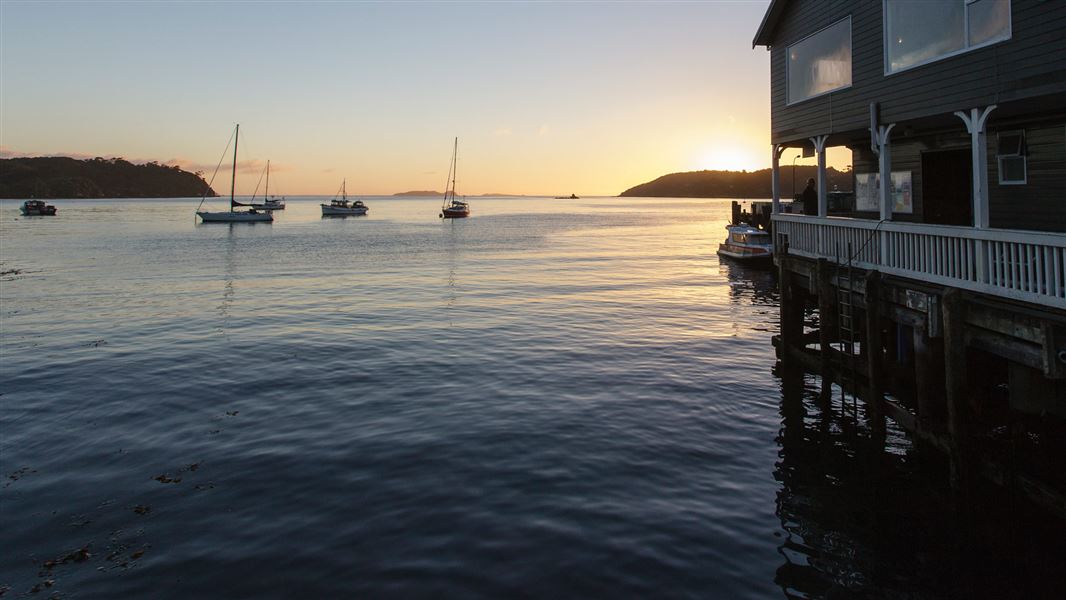From Halfmoon Bay, various facilities, walks and excursions are available, including visits to beautiful Ulva Island/Te Wharawhara Open Sanctuary and access to Rakiura Track Great Walk.
Take time to relax and explore the history and natural features of this southern paradise or take part in the hunting, fishing or diving opportunities available.
Visitors arrive in Halfmoon Bay by ferry or, for people who fly, by shuttle from the Ryan's Creek airstrip. The ferry leaves from Bluff and takes one hour while flights to the island leave from Invercargill airport and take 20 minutes.
Plants
The tall forest trees around Halfmoon Bay are mainly kāmahi and rimu. Rimu, miro and tōtara provided timber for the early settlers. Kāmahi is the most common tree, with its spreading trunk blotched a whitish colour, and its leaves toothed and slightly waved. Rata is also widespread and in summer it is readily identified by its bright red flowers.
The forest understorey is composed of lancewood, coprosmas, tree ferns and broadleaf. Fuchsia is common around Halfmoon Bay and is one of New Zealand's few deciduous trees. It has pale, loose, papery bark and handsome, pendulous purple flowers. The nectar is a favourite food for tūī and bellbirds, and pigeons feed on the purple fleshy berry, known as konini.
Ferns are an attractive and prominent feature of the forest. Many varieties can be found growing on the ground or hanging from trees.
Birds
For visitors arriving by boat their introduction to Stewart Island's birdlife is often the sight of sooty shearwaters, gulls, Buller's mollymawks, cape pigeons and little penguins.
Not far from Halfmoon Bay it is easy to see bellbirds, tūī and parakeets. Most island residents boast having these birds, as well as fantails and pigeons in their gardens. Summer evenings resound with the liquid melody of kākā high in the trees or calling across the waters of Paterson Inlet.
Grey warblers sing in the forest, particularly after rain, and tomtits are commonly encountered on the tracks.
The tidal areas of Paterson Inlet host a variety of wading birds including New Zealand dotterels, oyster catchers, herons and godwits. Around the seashores close to Halfmoon Bay, particularly at Ringaringa, there is much intertidal life to be discovered in the rock pools.
There are more kiwi on Stewart Island than people!
The people
People here are a little less hurried, much more friendly and a great deal more self-reliant than people in most other places. Many residents are direct descendants of the whalers and early Rakiura Māori, with combined family histories reaching back almost 200 years. Some of the houses built by the early Norwegian whalers are still lived in today, their distinctive alpine architecture somehow no longer out of place in the Roaring Forties of the Southern Ocean.
History
Oban's Halfmoon Bay has long been the focus of activity on Stewart Island/Rakiura. Visitors to Harrold Bay will see one of the oldest buildings in New Zealand, a stone house built by Lewis Acker in 1835. This was once the scene of ship building activity while Lonnekers Beach and Leask Bay are associated with early whaling and fishing industries.
In 1875 the island's first licensed hotel opened at Lonnekers Beach and the giant bluegums seen today were planted.
The Neck, the narrow peninsula of land at the eastern extremity of Paterson Inlet/Whaka a Te Wera, was also the scene of early activity. A site of Māori habitation, sealers and whalers joined the community early in the 19th Century. In 1864, when the island was sold to the crown The Neck was set aside as land for "half-castes", and grew to become the largest Māori settlement in the area. The Reverend JFH Wohlers, whose memorial at Ringaringa today overlooks his Southland coast parish, served The Neck settlement between 1844 and 1885.
By 1870 Halfmoon Bay was a small but active township, forming a residential base for fishing and timber industries. Communication and education improved with the establishment of a post office, school and several road links. A telephone cable was laid across Foveaux Strait in 1902 and in 1920 a refrigerator plant provided an important boost to the fishing industry.
Today blue cod, crayfish and paua fishing, salmon and mussel farming and tourism comprise the island's main industries.
Rakiura National Park Visitor Centre
| Phone: | +64 3 219 0009 |
| Email: | stewartisland@doc.govt.nz |
| Address: | 15 Main Road Oban 9818 |
| Hours: | Visitor centre hours and services |
